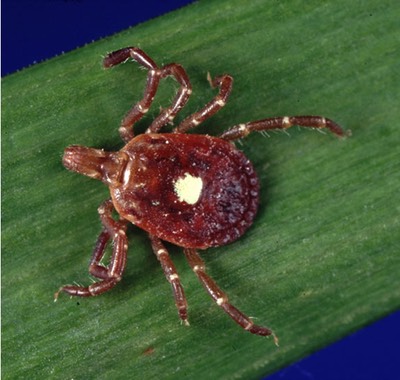News items, stories and information about ticks from around the region and beyond.
Gulf Coast ticks in Fairfield County CT
August 24, 2020
The discovery of the Gulf Coast ticks at an undisclosed location in Fairfield County was announced on Monday, Aug. 24, 2020 by the Connecticut Agricultural Experiment Station. The ticks could cause the health concerns in both humans and dogs, the station said.
According to Dr. Goudarz Molaei, a research scientist who also directs the CAES Tick Surveillance and Testing Program, this is the first report of populations of the Gulf Coast tick in the northeastern United States.
“Considering the role of this species in transmission of pathogens of medical and veterinary importance, this finding highlights ongoing challenges associated with range expansion of tick species into Connecticut, a state already with pervasive populations of blacklegged ticks and established populations of lone star ticks.”
Bovine babesiosis: FFAR Grant Addresses Cattle Fever Tick Re-Invasion in Texas
Apr. 30 2020
Bovine babesiosis: FFAR Grant Addresses Cattle Fever Tick Re-Invasion in Texas

In addition to market volatility threats from the current COVID-19 pandemic, Texas cattle ranchers have been battling another threat: the southern cattle fever tick (Rhipicephalus microplus). This tick can carry pathogens that cause deadly cattle fever, bovine babesiosis, for which there is no vaccine or treatment. When the tick is found on cattle, ranches or even adjacent areas, all cattle must be quarantined – which causes significant economic hardship.
Cattle fever ticks were eradicated in the US in 1943, with the exception of a permanent quarantine area along the border between South Texas and Mexico. White-tailed deer and nilgai facilitated the reintroduction of the tick outside the quarantine areas and into other areas of Texas. Cattle fever ticks are a threat if they carry the cattle fever pathogens, which can kill 70 to 90 percent of infected cattle. While no ticks in the US have tested positive for the pathogens, they are present in Mexico.
First Multiplex Test for Tick-Borne Diseases
Feb. 16 2018
PROMISING TO REVOLUTIONIZE DIAGNOSIS, A SINGLE BLOOD TEST CAN NOW ACCURATELY DETECT IF SOMEONE HAS LYME DISEASE AND/OR ONE OF SEVEN OTHER TICK-BORNE DISEASES
A new blood test called the Tick-Borne Disease Serochip (TBD Serochip) promises to revolutionize the diagnosis of tick-borne disease by offering a single test to identify and distinguish between Borrelia burgdorferi, the pathogen responsible for Lyme disease, and seven other tick-borne pathogens.
Case of Bourbon virus, rare tick disease, is confirmed in Missouri
SPRINGFIELD, Mo. (KY3) - Here's a warning about a rare, potentially deadly virus that is transmitted by ticks. The Missouri Department of Health and Senior Services confirms it is aware of a case of Bourbon virus in the state.
Powassan Virus Spreads In Ticks Along Maine Coast
Researchers Urge Caution As Powassan Virus Spreads In Ticks Along Coast https://t.co/cGXhyXKol3
— IdentifyUS (@IdentifyUS) April 26, 2017
May 2017 - Two Midcoast Main residents contract serious tick-borne virus
AUGUSTA — The Maine Center for Disease Control and Prevention announced Wednesday that two Midcoast adults contracted Powassan Encephalitis.
Both cases were reported to the CDC last week. In the two cases, the individuals became ill in late April and were hospitalized. The cases were confirmed through testing at CDC's center in Fort Collins, Colo. Both individuals were released from the hospital and are recovering.
Powassan virus case in Southern NH
This article first appeared on WMUR News 9 as reported by Adam Sexton on wmur.com
CONCORD, N.H. - Two viruses that have never been seen in New Hampshire before have shown up in the same person. The Department of Health and Human Services said a man from Hillsborough County has tested positive for both the Jamestown Canyon virus, which is transmitted by infected mosquitoes, and the Powassan virus, which is carried by ticks.
Public health director Dr. Jose Montero said both viruses have been around the United States for a while, and the Powassan virus has been found in Maine and Vermont, so the New Hampshire case is not a surprise.
He said residents should take the same precautions they use to prevent other mosquito and tick viruses, including wearing effective insect repellent and doing regular tick checks.
Read more on WMUR News 9 or in the Nashua Telegraph
Confirmed case of potentially fatal tick borne virus in Saratoga County NY
This article was written and reported by Lindsay Nielsen, Reporter at NEWS10 ALBANY
SARATOGA, N.Y. - A study conducted in part by researchers at the Wadsworth Center in Slingerlands revealed that a potentially deadly tick borne virus has been found in people in Saratoga and Albany County.
The New York State Department of Health and the Saratoga County Health Department says there was one confirmed case of the deer tick virus, also known as Powassan virus, in May of this year in Saratoga County.
According to the Centers for Disease Control its one of the 16 confirmed cases in New York State. According to the CDC it did kill a patient in Minnesota taken care of by Dr. Justin Birge.
"So brain swelling from the virus was what caused her death and it led to respiratory failure and coma," said Dr. Birge.
Dr Birge says the tick borne illness can be hard to diagnose because its beginning symptoms are similar to the flu, but severe symptoms are more noticeable.
"Certainly something like altered level of consciousness, being very sleepy,"said Dr. Birge.
Dr. Birge says someone infected may not have symptoms until two weeks later, and testing for the virus is difficult. Perhaps the most troubling part of the deer tick virus is the lack of a cure.
"In terms of treating the viral infection in itself there's no treatment," said Dr. Birge.
Dr. Laura Kramer with the Wadsworth Center tells NEWS10 that one person has died from this virus. She says the person died within 8 months of severe symptoms.
Symptoms people face after contracting Powassan virus include drowsiness, lethargy, headache and fever.
Dr. Kramer says the virus ultimately leads to death in about 10 to 30 percent of the cases.
She says the virus is transmitted at a rapid rate, about 15 minutes, as compared to Lyme disease which is transmitted in about two days.
Researchers at the Wadsworth Center found that the amount of ticks with this deadly virus are increasing, and if someone has been bitten by a deer tick, there is a one in 20 chance that it has the fatal illness. They have been found in Saratoga, Albany, Rensselaer and Columbia Counties.
The Albany County Health Department says there was one confirmed case in the county in 2004.
Read more on News10 ABC in Albany NY
Lone Star Ticks Moving West on Long Island
NBC Channel 4 News in New York reports that the lone star tick, found for decades mainly on Long Island's East End, has been moving west into more populated Suffolk County communities, according to a county health official. Read more here.
Heartland virus found in Lone Star ticks

As reported in MedPage Today, the lone star tick, Amblyomma americanum, appears to be the source of the novel virus that hospitalized two Missouri men in 2009, researchers reported.
A sample of ticks collected last year from the farms of the two men and a nearby site had the so-called Heartland virus, or HRTV, according to Harry Savage, PhD, of the CDC in Atlanta, and colleagues.
Read more about the original study in the American Journal of Tropical Medicine and Hygiene:
First Detection of Heartland Virus (Bunyaviridae: Phlebovirus) from Field Collected Arthropods
Further commentary about this same case found on NPR here.

